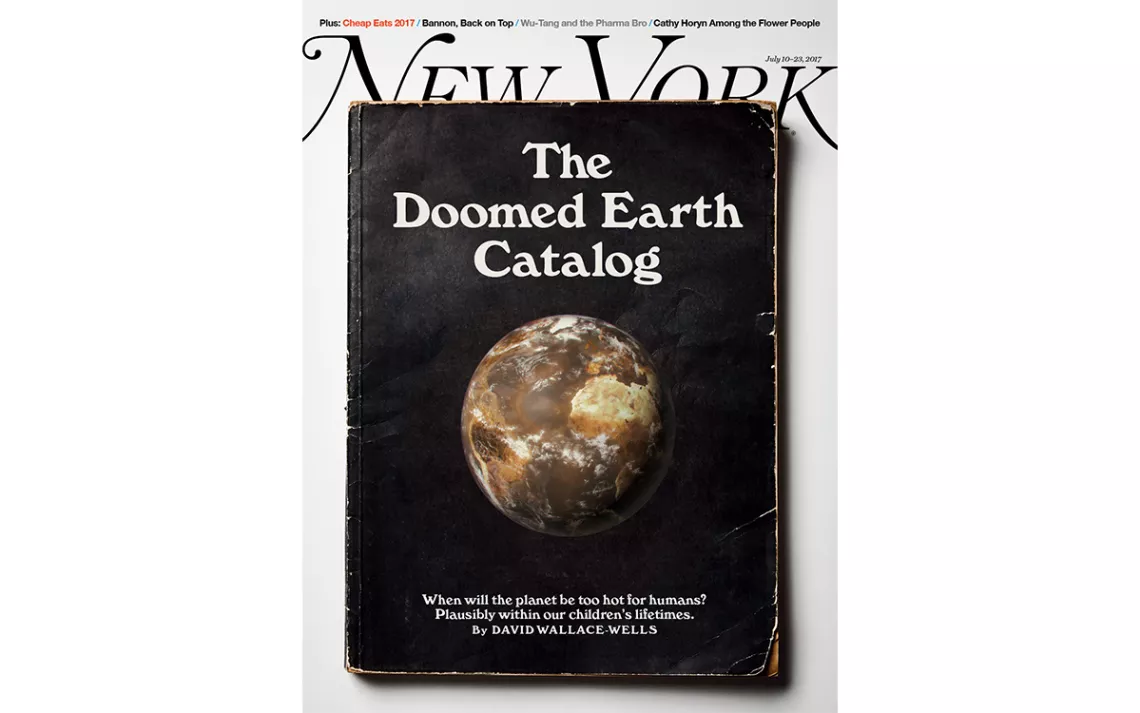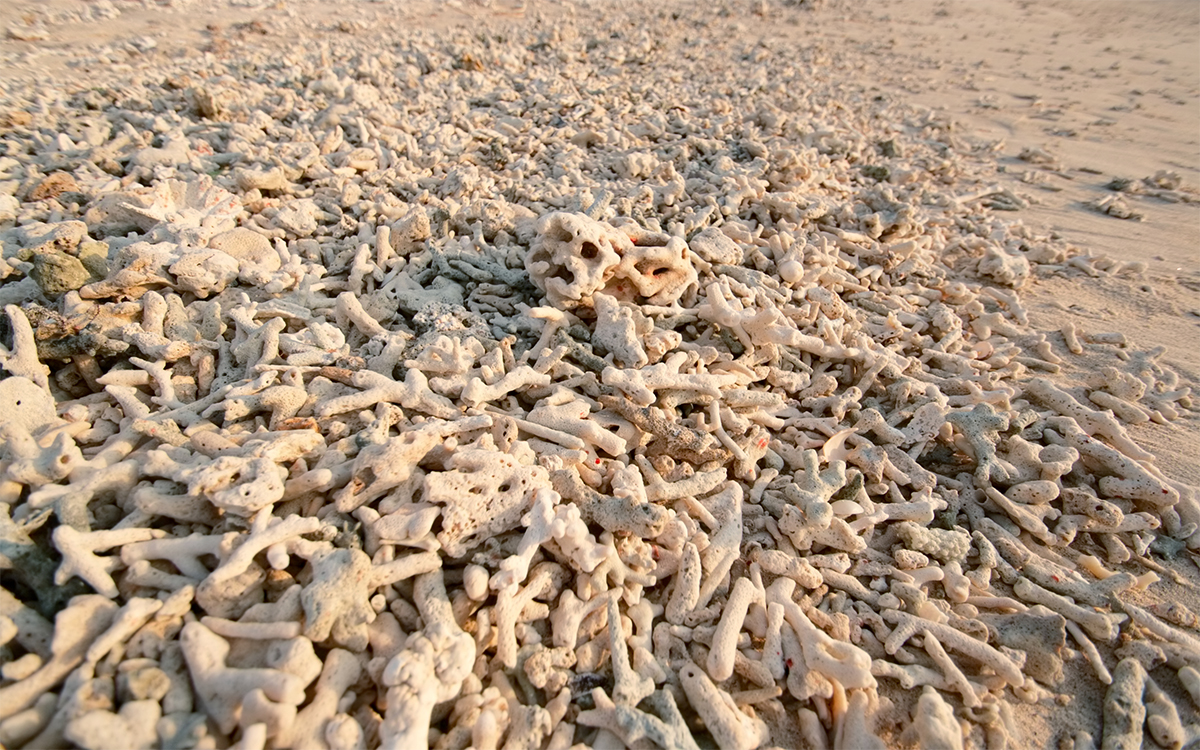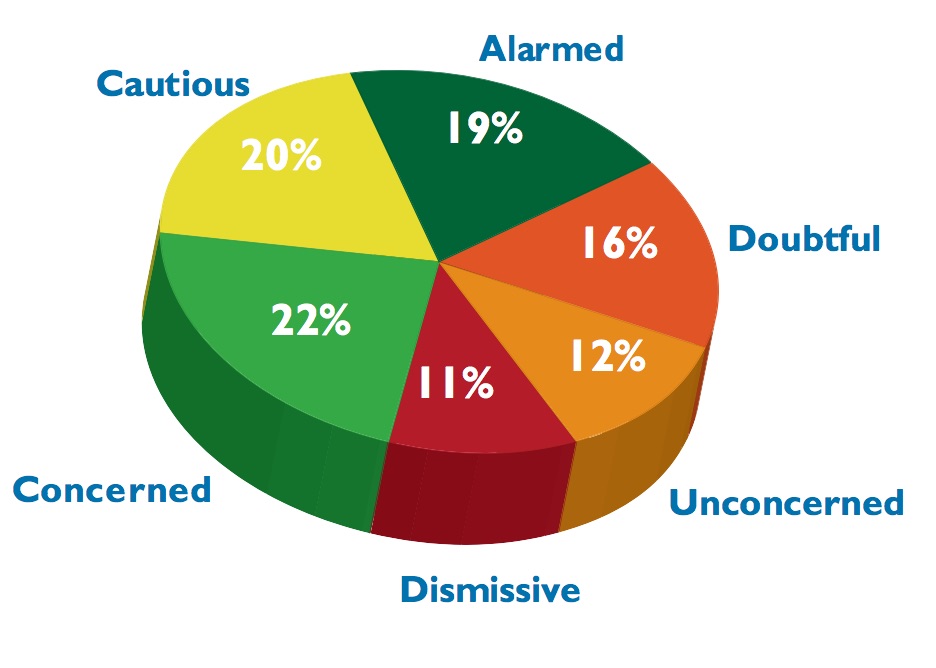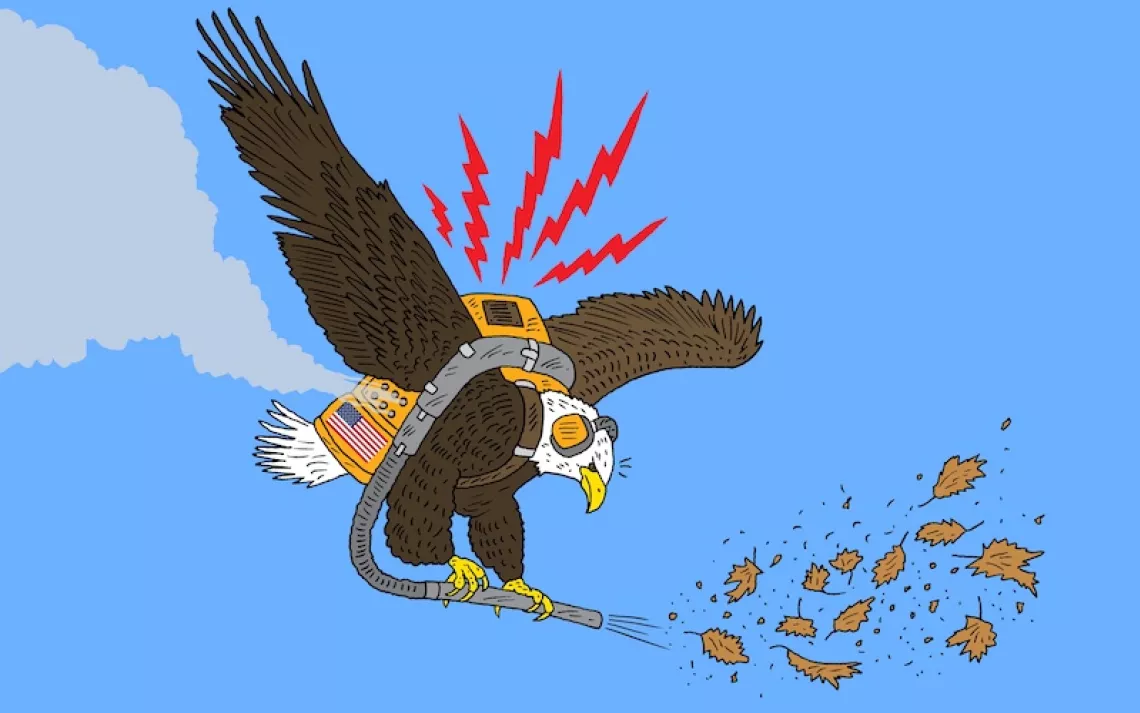Fear Factor: A Defense of NEW YORK's Climate Doom Cover Story
It’s OK to talk about the terrifying worst-case climate change scenarios

Image courtesy of New York magazine
In the not-so-distant future (the lifetime of a person born today), large portions of Earth may become inhospitable to human life, if not totally uninhabitable. Rising temperatures might scorch the world’s great grain baskets, leading to famine and contributing to war. Extinctions will continue to mount. Diseases locked in ancient ice could sweep the planet, producing plagues like we’ve never experienced. If humanity fails to radically reduce global greenhouse gas emissions, “much more dying is coming.”
That nightmarish doomsday scenario arrives courtesy of the current cover story in New York magazine, titled “The Uninhabitable Earth.” Since it was published, on June 10, the blockbuster piece (now the most-read in the magazine’s history) has ignited a firestorm of controversy, with many scientists complaining that it exaggerates the science of climate change, and a host of environmental journalists offering their hot-takes on the article. At this point, the Twitter debates on the essay probably measure in the gigabytes.
The 7,300-word article, by David Wallace-Wells, is essentially a thought experiment: What could happen to the planet and civilization if humanity fails to make dramatic reductions in greenhouse gas emissions in the coming decades? Wallace-Wells writes, “What follows is not a series of predictions of what will happen—that will be determined in large part by the much-less-certain science of human response. Instead, it is a portrait of our best understanding of where the planet is headed absent aggressive action.”
A portrait of our best understanding? Not exactly, a chorus of climatologists says. Scientists complain that the article misstates some facts, misrepresents others, and, in general, paints a misleading picture of global warming worst-case scenarios.
“I thought it was over the top,” Ken Caldeira, a climate scientist at the Carnegie Institute wrote to me in an email, in which he suggested that the article seems to be an example of cherry-picking data to support an existing world view—in this case, the idea that humanity is well and truly screwed.
James Hansen, the former NASA climatologist and now Columbia University researcher who was the first scientist to bring climate change to the general public’s attention, wrote to me, “I agree with the reaction of scientists, that such exaggerated reporting does more harm than good.” (Hansen also expressed frustration at the writer’s statement that he had dropped his support for a carbon tax; the magazine has since run a correction on that point.)
Beyond the writer’s factual overstretching (which is important, as I’ll get to in a minute), the larger complaint from the scientific community is that the article’s doom-laden tone—its whole gambit of sketching out a worst-case scenario—is unhelpful.
Here’s Penn State climatologist Michael Mann, probably the most vociferous critic of the New York article, writing in Thursday’s Washington Post: “The evidence that climate change is a serious challenge that we must tackle now is very clear. There is no need to overstate it, particularly when it feeds a paralyzing narrative of doom and hopelessness.”
When I first read the article, I also worried that it was overblown and, if taken out of context, could further inure people to the clear and present danger of global climate disruption. The prospect of the end-of-the-world-as-we-know-it can be an excuse for inaction, a justification for nihilism. After all, if we’re all doomed, why not keep partying until the booze and cigarettes (or, as the case may be, the oil and coal) run out?
But in the last week, I’ve come to a different conclusion: Maybe such an over-the-top depiction of climate change’s worst-case scenarios is useful, essential even. “The Uninhabitable Earth” can be like a splash of cold water to the face, waking up society from its sleepwalk toward life-threatening climate dislocations. All too often, climate change reporting is boring, or at least hard to track if (like most people) you’re only following the story out of the corner of your eye. A planetary disaster unfolding in slow motion lacks the immediacy of, say, Donald Trump Jr.’s real-time self-incrimination. In contrast, Wallace-Wells’s story is vivid and visceral. It is, in a word, terrifying.
And that’s a good thing. At this point in time, with carbon dioxide and methane continuing to accumulate in the atmosphere and the oceans becoming warmer and more acidic, a measure of terror isn’t unreasonable. A good dose of fear might in fact be just the propellant civilization needs to take immediate, dramatic action.
Make no mistake: Hope—the renewable energy of any successful political movement—is essential for addressing the climate crisis. But hope alone is insufficient. If society is going to avoid the worst climate change impacts, some rational panic is also in order. There is such a thing as doom without gloom. Fear, just as much as hope, can fuel a righteous global movement to decarbonize civilization.

Dead coral on a beach | Photo by lore/iStock
*
Let’s get some unpleasantries out of the way: Wallace-Wells’s story isn’t without its faults. In a lengthy discussion at Climate Feedback, a group of 17 scientists have identified what they say are inaccuracies in the piece. As Mann and others point out, the writer appears to make a glaring error when he states that since 1998 the globe has warmed “more than twice as fast as scientists had thought.” According to these climate scientists, Wallace-Wells also overstates the likelihood of melting permafrost unleashing a flood of methane into the atmosphere. The section about “the end of food” is, according to one commentator, “hyperbole.”
I’m no scientist, but I immediately found some parts of the essay to be just, well, silly. Supposedly, ancient plague locked in “bubonic ice” could reemerge and sweep the planet. Really? This is like Jurassic Park meets Interstellar—more fiction than science.
And still. I think the piece is worth reading if you haven’t already. It’s worth forwarding to your friends and relatives and sharing on social media. It should be read by as large an audience as possible.
(To be perfectly clear, I’m not excusing journalistic sloppiness. Even when conducting a thought experiment, a writer has to get the facts right; the best science fiction is based on real science. For his part, Wallace-Wells has posted a series of rebuttals to the claims of inaccuracy on Twitter, and New York has published a thoroughly annotated version of the piece, here.)
Wallace-Wells’s essay is a calculated provocation designed to shake some people out of their complacency. In a phone conversation Thursday, Wallace-Wells told me that his intention was “to call attention to what lies beyond the median projected outcome for climate change. We seem to have a very good sense of what 2 degrees [Celsius] warming would look like, but we don’t have a sense of what’s beyond that median, and that means half of all possible outcomes. People think of 2 to 2.5 degrees warming, and that would be really bad, but they tend to think of that as the worst case that is possible, and so the psychological framework for action is anchored by the median outcome standing in for the worst-case scenario.”
While such dark imaginings have made some scientists uncomfortable, they have seized the public’s imagination. Wallace-Wells’s thought experiment has achieved his goal—insofar as the essay has grabbed the attention of people who don’t spend much time thinking about climate change. According to New York print editor Jared Hohlt, the article has had more than 2.5 million readers so far, making it a true viral hit. The last time an article about climate change made such a splash was probably back in 2012, when Bill McKibben’s Rolling Stone story “Global Warming’s Terrifying New Math” got a lot of people talking about the global carbon budget.
Given the article’s huge success, the concerns about the article seem misdirected. This is the last thing we need right now: scientists and journalists worrying that people are too worried about climate change, or worried for the “wrong” reasons. As Vox’s David Roberts puts it, in one of the best defenses of the essay I’ve seen, “By any sane accounting, the ranks [of] the under-alarmed outnumber the over-alarmed by many multiples.”
Exactly right. I have to wonder what’s worse: a relatively unknown writer exploring the worst-case scenarios of climate chaos, or one of the world’s preeminent climate scientists (Michael Mann) writing in the Washington Post that the concerns are overblown. In today’s media environment—in which social media acts as a light-speed-quick game of telephone—I’m afraid the latter is more likely to give solace to those who continue to push for reckless fossil fuel extraction.
*
Criticisms of the New York article rest, in part, on a concern that it is alarmist—that by focusing on worst-case scenarios, it overstates the threat of climate change and makes the climate movement vulnerable to being depicted as a bunch of Cassandras. It seems to me that such concerns are an expression of a sort of PTSD among climatologists—having been bullied, hounded, and even spied on (see: Climategate), climate scientists are understandably cautious about how they present their findings to the public. The caution is also the result of an academic bias toward the middle ground. The scientific community’s consensus on climate is a case of reversion to the mean: The public hears a lot about the “likely” impacts of climate change, and not much about the less likely, but far more worrisome, consequences of unchecked emissions.
And yet, as one scientist involved in the Climate Feedback dialogue, UCLA post-doc Daniel Swain, points out, “It is quantitatively true—and often underappreciated—that the likelihood of a ‘worse than expected’ climate future is actually higher than a ‘better than expected’ one.” Or, more plainly: It is more probable that climate change will be a disaster than that we’ll manage to avoid the worst impacts of treating the atmosphere like an open sewer.
Consider such probabilities and the complaints about the New York magazine article come to seem like grumbling over the attitude of the Titanic’s maître d’ as the ship slips into the North Atlantic. It’s an open secret among climatologists, policy experts, and environmental campaigners that staying within a global 2-degree temperature rise is all but impossible, barring some technological or political revolution. Wallace-Wells has simply laid that secret bare.
Embedded in the complaints about alarmism is a more sweeping criticism: The essay is simply fear-mongering apocalypse porn, and fear-based appeals don’t work when it comes to motivating people to take action on climate change. Here’s Mann in the Post: “Fear does not motivate, and appealing to it is often counterproductive as it tends to distance people from the problem, leading them to disengage, doubt, and even dismiss it.” And here’s meteorologist-journalist Eric Holthaus writing for Grist: “If you’re trying to motivate people, scaring the shit out of them is a really bad strategy.”
Really? I’m not so sure. There’s two problems with this line of reasoning: It’s not half as well grounded in science as the writers claim; and, more worrisome to me, it represents a kind of sentiment-censoring, an emotion-shaming that doesn’t allow space for the full range of feelings people might have regarding climate change.
First, the science. The study that Mann cites is more complicated than he makes it seem, with the researchers referring to one study that found “greater fear of climate change was associated with greater systematic processing of information about energy-related behaviors.” In lay terms: People who are anxious about climate change tend to pay more attention to their thermostat settings. Holthaus’s sources are equally a mixed bag: The first mostly focuses on whether fear can sway climate science deniers; the second is a Dr. Dean Ornish opinion essay based on anecdotes; and the third actually says nothing about fear at all.
Though fear as a motivator can “backfire,” as Holthaus’s first citation warns, fear can also be effective as a way of changing attitudes and behaviors. Fear, in fact, is an essential evolutionary tactic for survival—and that’s as true for human civilization as a whole as it is for individual humans.
For evidence of that, look no further than the public health field. Fear-based appeals have been used to discourage smoking and drunk driving and to raise awareness about sexually transmitted diseases. Fear-based appeals have successfully increased the percentage of women seeking breast cancer exams. As this study on reducing drunk driving notes, fear-based campaigns mostly fail when they aren’t accompanied by giving the audience “specific information about actions they can take to protect themselves.” Arousing fear is OK—as long as people have a sense of personal agency that there is something they can do to address that fear. And, I would say, there’s nothing wrong with arousing fear when the facts are, in fact, worrisome. Drunk driving can kill you; global temperature rise is not good for the planet’s well-being.
The health analog is important. Fear works when it comes to health because we’re all afraid of illness and death. And what is the climate crisis if not a threat to the body of the entire world? As I’ve written before, a public health frame might be one of the most effective arguments for moving public opinion on climate action, if only because everyone cares about heat stress and tropical diseases moving northward and their kids breathing ozone-thick air.
Agreed—Wallace-Wells’s dark vision isn’t going to convince climate skeptics to change their views. But that’s not really the task facing the climate movement anyway. Instead, the true challenge is to shift the percentages of what the Yale Project on Climate Change has called the “Six Americas.” Some of those in the “unconcerned” category need to move to “cautious"; some of those who are in the “cautious” pie slice need to shift to “concerned”; and some of the currently “concerned” need to get to “alarmed.” A little bit of alarmism—which is to say a dose of Wallace-Wells’s fear—is going to be required to make that happen.

Image courtesy of the Yale Project on Climate Change
My bigger concern with the fear-shaming is that it represents a one-dimensional view of human nature. Hope and fear have a Janus-like relationship; or, perhaps more accurately, hope and fear are like conjoined twins—two minds, sharing a single heartbeat. It’s hard to have one without the other.
*
Environmentalists should understand this. Just think of Silent Spring with its dystopic opening, “A Fable for Tomorrow,” clearly designed to inflame more than to inspire. Think of the efforts for wildlife conservation; people are motivated as much by the hope of preserving animal species as they are by the fear of losing species to extinction. Think of the grassroots campaigns to close coal plants, in which a fear of regional air pollution has motivated activists as much as an aspiration for a clean energy economy has.
To be sure, there are real dangers in fear-based appeals, which can lead to a cramped and greedy politics. But there’s also a risk in relying solely on hope, which at best leads to a superficial optimism, at worst to a clueless Pollyanna-ism, a willful blindness untethered to reality.
At the historic September 2014 People’s Climate March in Manhattan, the banners read, “To Change Everything, We Need Everyone.” I think the same could be said for emotions: To adequately respond to the climate crisis will require us to embrace the full range of human emotions, fear among them. Some days we will feel sadness, like when we hear about the bleaching of the world’s coral. Some days we will feel anger, like when we learn of another species cast into the void of extinction. Some days will bring optimism, a steely resolve fueled by seeing hundreds of thousands marching for science or rallying for clean energy. When all else fails, gallows humor might have to do.
But if you’re not fearful about climate change, either you’re not paying attention or you’re fooling yourself.
So go and read “The Uninhabitable Earth.” Get scared. Then get to work making sure those fears don’t come to pass.
 The Magazine of The Sierra Club
The Magazine of The Sierra Club






